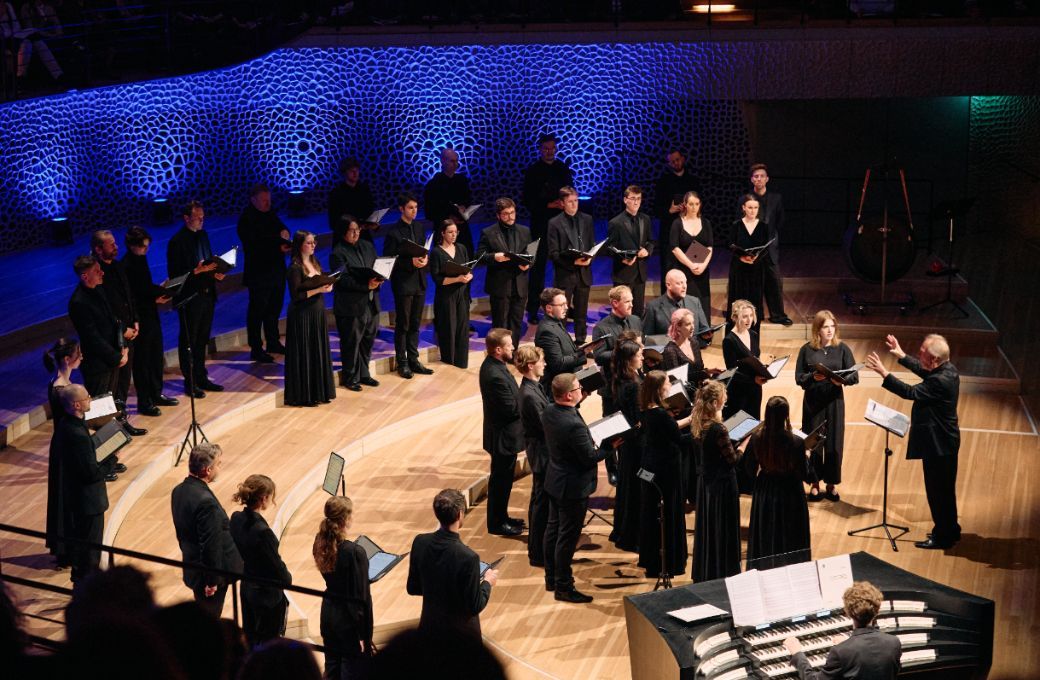Tenebrae’s a cappella concert at the Elbphilharmonie felt more like a vast sound installation. Under Nigel Short’s direction, the ensemble vividly choreographed sound: using movement, positioning and spatial design to make vocal polyphony visible. The placement of singers on stage was much like an organist pulling different stops to shape timbre and resonance.

The evening’s most compelling dialogue unfolded between Renaissance masterpieces and their contemporary reflections. Byrd’s Ave verum corpus – a quintessential emblem of the English choral tradition – was delivered with unerring poise and luminous tone. In Roderick Williams’ Ave verum corpus re-imagined, that familiar sacred fabric was deliberately torn open: sustained tones, stretched melodic contours and the fragmentation of polyphonic texture created a sonic fissure within the original. Particularly striking was the dialogue between an added chanting tenor and the surrounding ensemble, a gesture that seemed to question, even haunt, Byrd’s serene balance. The result was a musical metaphor reminiscent of Francis Bacon’s deformations of Velázquez’s Pope Innocent X: the sacred image both preserved, suspended and distorted.
A similarly intriguing dialogue unfolded in the concert’s final pairing: Tallis’ monumental Spem in alium, preceded by Unsuk Chin’s Nulla est finis, a prelude of fragmentary, incantatory utterances that hovered between speech and song. From sparsely positioned singers came whispering syllables and ritualised breaths, summoning the vast choral architecture to come. When Tallis’ forty-part monument finally rose from this sonic mist, it felt immense yet transparent within the crystalline acoustics of the Elbphilharmonie – an experience with rare structural clarity, unattainable in the resonant haze of normal cathedrals.
The second major focus of the programme revolved around Arvo Pärt and his contemporaries. Tenebrae avoided the cliché of portraying Pärt as an apostle of silence, instead shaping his works with subtle contrasts of texture and space. The first two pieces in the second half drew strength from the organ, first as a sustained drone, then as a surging, almost Vierne-like force. The following miniatures distilled Pärt’s tintinnabuli idiom to its transparent essence: voices unfolded with ballade-like directness and narrative clarity, each phrase resonating clearly within the hall.
In parallel, Eric Whitacre’s lengthy When David Heard explored the human voice’s physicality: short gasps, low chants and gradual cumulative build created an overwhelming wave of grief. Tavener’s Song for Athene extended the exploration into space: the choir was divided into three distant groups, with deep basses on stage, a solo tenor intoning chant-like phrases, and two clusters in the gallery. Enhanced by subtle stage lighting, the effect was reminiscent of standing inside an underground cavern, with sound enveloping the listener from all directions.
The only real shortcoming of the evening came in the reworking of Orlando Gibbons’ well-known anthem Drop, Drop Slow Tears into a solo–ensemble dialogue, which blurred its contrapuntal precision. Despite the beautiful intention, the clarity and tight contrapuntal focus of Gibbons’ original conception were somewhat diluted.
While this concert is part of Elbphilharmonie Arvo Pärt 90 series, its true value lay in presenting a contemporary tapestry of choral music: a woven panorama of the most serious vocal investigations, exploring textures, spatial possibilities and the expressive potential of the human voice across centuries.


